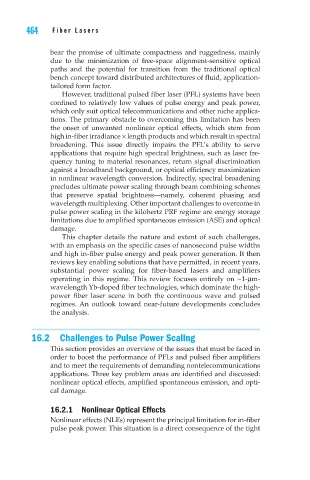Page 496 - High Power Laser Handbook
P. 496
464 Fi b er L a s er s Pulsed Fiber Lasers 465
bear the promise of ultimate compactness and ruggedness, mainly
due to the minimization of free-space alignment-sensitive optical
paths and the potential for transition from the traditional optical
bench concept toward distributed architectures of fluid, application-
tailored form factor.
However, traditional pulsed fiber laser (PFL) systems have been
confined to relatively low values of pulse energy and peak power,
which only suit optical telecommunications and other niche applica-
tions. The primary obstacle to overcoming this limitation has been
the onset of unwanted nonlinear optical effects, which stem from
high in-fiber irradiance × length products and which result in spectral
broadening. This issue directly impairs the PFL’s ability to serve
applications that require high spectral brightness, such as laser fre-
quency tuning to material resonances, return signal discrimination
against a broadband background, or optical efficiency maximization
in nonlinear wavelength conversion. Indirectly, spectral broadening
precludes ultimate power scaling through beam combining schemes
that preserve spatial brightness—namely, coherent phasing and
wavelength multiplexing. Other important challenges to overcome in
pulse power scaling in the kilohertz PRF regime are energy storage
limitations due to amplified spontaneous emission (ASE) and optical
damage.
This chapter details the nature and extent of such challenges,
with an emphasis on the specific cases of nanosecond pulse widths
and high in-fiber pulse energy and peak power generation. It then
reviews key enabling solutions that have permitted, in recent years,
substantial power scaling for fiber-based lasers and amplifiers
operating in this regime. This review focuses entirely on ~1-μm-
wavelength Yb-doped fiber technologies, which dominate the high-
power fiber laser scene in both the continuous wave and pulsed
regimes. An outlook toward near-future developments concludes
the analysis.
16.2 Challenges to Pulse Power Scaling
This section provides an overview of the issues that must be faced in
order to boost the performance of PFLs and pulsed fiber amplifiers
and to meet the requirements of demanding nontelecommunications
applications. Three key problem areas are identified and discussed:
nonlinear optical effects, amplified spontaneous emission, and opti-
cal damage.
16.2.1 Nonlinear Optical Effects
Nonlinear effects (NLEs) represent the principal limitation for in-fiber
pulse peak power. This situation is a direct consequence of the tight

